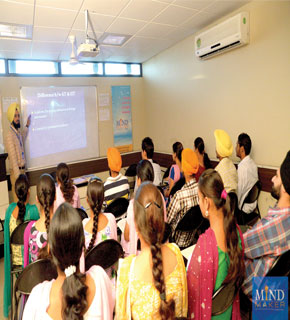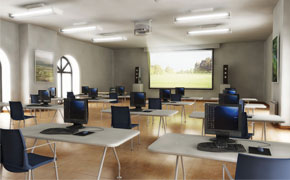
 The audio visual educational instructions stimulate the eyes and the ears the best. The successful use of motion pictures and other visual aids by the US armed forces during World War II demonstrated the effectiveness of this medium. Today, India is the leading market for audio visual medium in the field of education, attracting attention worldwide. The Elets News Network is all ears to learn an audio visual lesson
The audio visual educational instructions stimulate the eyes and the ears the best. The successful use of motion pictures and other visual aids by the US armed forces during World War II demonstrated the effectiveness of this medium. Today, India is the leading market for audio visual medium in the field of education, attracting attention worldwide. The Elets News Network is all ears to learn an audio visual lesson
India is now the world’s fastest growing market for audio visual (AV) equipment. A study by industry association Infocomm has suggested that the audio visual market in India is expected to show a high compounded annual growth rate of 25 per cent to touch $ 5.1 billion by 2015, on the back of spending in sectors such as education, infrastructure and corporate information technology. On the other hand, the global AV market is projected to grow by 14 per cent to generate $115 billion by 2015, the study said. The audiovisual industry currently generates $91 billion a year and is projected to be a $114 billion global industry by 2016. “The AV industry is strong, thanks to a rebounding economy and a growing need for collaboration,” said David Labuskes, CTS, RCDD, Executive Director and CEO, Infocomm International. “However, growth is not universal across the world, and the strength of the burgeoning Asian market will overtake the North American market in size for the first time in 2016.”
One of the largest vertical markets in the audiovisual industry is higher education. Audio visual material must be seen in their relationship to teaching and to the learning process as a whole. Today, even a 4-5 year old is exposed to a range of technologies to which previous generations had no access to: television, DVDs, iPods, Nintendo Wiis, computer games, the internet, smart phones…the list is long. Equipment used for audiovisual presentations include dioramas, magic lanterns, planetarium, film projectors, slide projectors, opaque projectors (episcopes and epidiascopes), overhead projectors and tape recorders. The audio visual materials are produced, distributed and used as planned components of educational programs. When audiovisual aids materials are used intelligently, they can promote the most effective kind of learning, in adults as well as children, in college as well as grade school, everywhere.
The clients often have a higher number of rooms within their facility that incorporates audiovisual technology than other large verticals, such as house of worship or corporate. With an increasing number of big corporate houses entering the educational sector with ERP solutions, there are a lot of educational institutes taking help from the advanced technologies to upgrade their age old system. Also, with an advent of 3G and now 4G Internet connectivity and Internet-enabled TVs and Wifi consoles, video-based learning in schools is witnessing an unparalleled growth.
According to a report ‘Education in India: Securing the demographic dividend,’ published by Grant Thornton, the primary and secondary education, or K-12 sector is expected to reach $ 50 billion in 2015 growing at an estimated compound annual growth rate (CAGR) of 14 per cent. Simultaneously, the professional audiovisual industry is a multibillion- dollar industry, comprising the manufacturers, dealers, systems integrators, consultants, programmers, presentations professionals and technology managers of audiovisual products and services. Richard Tan, General Manager of Infocomm’s Asia subsidiary, said that corporations in India continue to significantly invest in new technology despite the economic slowdown. By 2015, India is set to become the third largest market in Asia Pacific, he added.
Due to its sheer size and enormous growth potential, the Indian education market is attracting major manufacturers and system integrators as a very lucrative one. The result is that the market now faces cut throat competition and buyers are trying to get the best solution at the lowest price. When technology is purchased purely based on price, quality is risked, which has led to products of questionable quality being imported and rebranded in India to match the lowest price expectation on the box, without focusing the quality of the total solution, and reliability of after sales support. Fortunately, the market has witnessed a growing awareness, especially private schools, who evaluate various technologies before designing total student information and school management solution, focusing on quality and reliability in addition to affordability.
With the coming of solution providers like Educomp, HCL etc, who integrate audio visual devices and provide a complete solution to educational institutions, the market is growing rapidly. For example, HCL, a big vendor, will buy projector from Panasonic and hire speakers from speaker brands and integrate all the hardware and will give a complete solution to the educational institutions.
Ramya Chatterjee, Director, Sales & Marketing, Cybernetyx said, “India is a developing country. However, Indian market has moved beyond the nascent stage, and is witnessing a steady growth in demand of AV Products. Indian schools have understood the pros of highly interactive environment of full-fledged Digital Class room. For multinational companies involved in production of AV products including interactive whiteboard, Projector etc., India and China are the two major emerging economies expected to drive significant growth. The interactive whiteboard market in India is driven by a growing demand from the education sector, where there is increased focus on ICT adoption and a conscious effort to make the learning process more interactive for students, in tune with a global trend.”
The India market is also different, thanks to the rural urban divide and vast geographical differences. Growth has to be inclusive and the problems faced by the urban Indians are vastly different from the ones in rural India. Although business will be good in metro cities, schools in remote villages could be a challenge, not only in infrastructure, but also due to mind set issues. Also, there are locations where technology has not been able to bring about change. Enabling the rural populace, by providing the right infrastructure, should be a top priority. What in India is taken something as casually as ‘load shedding’, in the United States the ‘power cut’ can take form of a national crisis. That shift in mentality will not happen overnight but it is indispensable that we compete to be at par with developed nations.
‘Stumbling Blocks’ in use of Audio Visual aids at educational institutes:
- Inability of teachers to use Audio Visual aids
- Wrong perceptions of parents regarding the medium
- Shortage of funds
- Attitude of Teachers and School management
- Inappropriate teacher training programmes
One of the largest vertical markets in the audiovisual industry is higher education. Audio visual material must be seen in their relationship to teaching and to the learning process as a whole. Today, even a 4-5 year old is exposed to a range of technologies to which previous generations had no access to: television, DVDs, iPods, Nintendo Wiis, computer games, the internet, smart phones…the list is long.
Since advent of the Modi government, the concept of audio visual in schools with smart classes has become even more relevant. Besides private schools, even government schools in states like Gujarat, Jharkhand, Uttar Pradesh and southern states are making use of audio visual lessons.
Chatterjee further explains: “Several government initiatives encouraging the use of AV & ICT technology in schools and colleges have significantly benefitted the industry and should continue to drive growth in the future. The Union Budget has addressed some of the needs in the education space and has set the pace for new reforms have been introduced. Considering that the rural population constitutes 70% of India’s population, focusing on the employment of the rural youth would be critical. Keeping this objective in mind and to give a boost to employment of students in the rural areas, the Deen Dayal Upadhyay Gramin Kaushal Yojana was launched in September 2014 and Rs 1,500 crore has been allocated to the scheme. There are investments from the State Govt. level as well. PPP and implementation of AV/ICT in Govt. Educational institutions under BOOT model is also a very effective to drive growth & technology penetration in both urban & rural India.”
“Some of the key highlights of Govt. initiatives that may boost India’s AV market in Education vertical are: AIIMS in Jammu and Kashmir, Punjab, Tamil Nadu, Himachal Pradesh, Bihar and Assam – IIT in Karnataka – Indian Institute of Mines in Dhanbad to be upgraded to IIT – PG institute of Horticulture in Amritsar – Kerala to have University of Disability Studies – Centre of film production, animation and gaming to come up in Arunachal Pradesh”, says Chatterjee.
The ambitious National e-library project, which aims to create a e-library besides designing an audio-visual interactive platform for students and academic fraternity in the country, is set to become operational by next academic year. The project aims to provide academic content through the Internet and is part of Narendra Modi government’s initiative to promote education. Several nations like Norway, the UK, Israel have shown keenness to participate in the project with international partnership also likely to worked out with Unesco. In his Teachers’ Day interaction with students Prime Minister Narendra Modi had expressed his desire that students and teachers should utilise technology. It is learnt that the project has a strong backing of HRD minister Smriti Irani who is keen for the roll-out of the ambitious national e-library project in the academic year 2015.
According to a report ‘Education in India: Securing the demographic dividend,’ published by Grant Thorton, the primary and secondary education, or K-12 sector is expected to reach $ 50 billion in 2015 growing at an estimated compound annual growth rate (CAGR) of 14 per cent.
With the gloomy outlook of the US and UK market, many are now turning to Asia to expand their market share. India’s status in the global picture, especially Asia, can be understood from one thing. Malaysia has set an ambition of completely digitized education by 2020. In May 2012, its Prime Minister, Dato’ Sri Mohammad Najib Tun Razak, has said that Malaysia is extremely likely to adopt cheap tablet computers such as those developed in India. With the ‘Make in India’ mission, it is important that we focus on enhancing our capabilities as a manufacturers and users as one of the biggest and most lucrative market.
 To sum it, in India, a “chasm” is opening up between schools that are using audio-visual technologies successfully and those that are still waiting for a national policy to be developed, but audio visual is the future of education.
To sum it, in India, a “chasm” is opening up between schools that are using audio-visual technologies successfully and those that are still waiting for a national policy to be developed, but audio visual is the future of education.






















